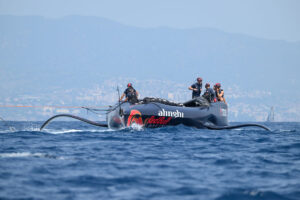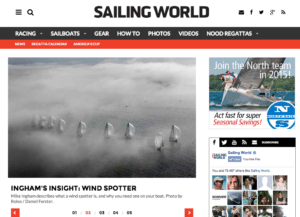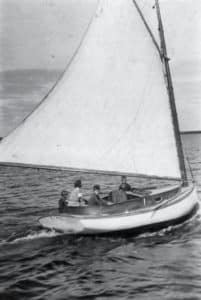Inside a crowded conference room at the International Sailing Federation Annual Meeting in Athens, Greece, the atmosphere was intense. The issue at hand in this particular session was a decision on the equipment (boats) to be used in the 2016 Olympic Games in Rio de Janeiro. Emotions were running high. Around the table sat 50 delegates, and a few hundred more observers, each with some vested interest, sat in the shadows. Before the meeting, there had been considerable speculation on the outcome of this one influential session, but no one could predict with any certainty what the outcome would be.
Chris Atkins, of England, kept the meeting running smoothly and its committee members focused on the task at hand, their efforts never once derailed by the many odd comments and questions put forth to the group. Former U.S. Sailing Team head coach Gary Bodie sat at the table as the U.S. representative. Sertle sat behind him, as did other American supporters, Liz Baylis, Dina Kowalyshyn, Ethan Bixby, and me. It was the first time I’d sat in on an ISAF Annual Meeting session.
Although ISAF is the governing body of our sailing, I know many sailors who know little about how decisions affecting our sport are made. Throughout the year, ISAF collects submissions from its Member National Authorities (i.e., US SAILING) and committees. These submissions propose changes to rules, regulations, procedures, and governance of sailing.
ISAF publishes more than 100 submissions well before its Annual Meeting, allowing MNAs to discuss independently before coming to the table. One month before the meeting last November, about 25 of us at US SAILING [Ed’s note: Jobson is president of US SAILING] discussed the Olympic equipment question, as well as a dozen other submissions that we felt would substantially impact the sport.
While there was much on the agenda, the Olympic equipment question, however, was the hot button of the 2010. There was a strong lobby on behalf of persevering the Star, the longstanding men’s keelboat. There were also movements to establish a new class, a co-ed mixed multihull, a women’s doublehanded 29er class, and even a kiteboard discipline. The intended outcome of this session was only to deliver a recommendation to the ISAF Council, which will have the final say in May.
As is well known today, the Star did not make the cut. The class has certainly had a good run since being introduced to the Games in 1932, but it was unceremoniously ousted. A mixed multihull discipline and a women’s keelboat event drew the most votes, but there was also strong support for making the International 470 class a co-ed discipline as well. The men’s heavy one-person dinghy (Finn) prevailed, and a new women’s doublehanded class, not necessarily the 29erXX, was put to the “under consideration” column.
Brazil’s delegation was disappointed the Star was knocked out so unceremoniously. Given their historical prowess in the class, their displeasure was not surprising, and they plan to push the International Olympic Committee to add an 11th discipline so the Star would not be brushed aside. The prospects of such a thing happening, however, are doubtful.
The ISAF was established in October 1907 as the International Yacht Racing Union. It was a vibrant time for sailing in 1907 when the Universal Handicap Rule was created, and the organization has evolved over the years. It meets twice a year, and the spring meeting has considerably smaller attendance, but it is where final decisions are made. More than 130 Member National Authorities exist under the ISAF umbrella, and when it comes to decisions impacting the sport, the United States, like every MNA, gets one vote, even though it has a large number of sailors and yacht clubs. Historically, the United States has had strong representation in order to have its voice heard. Among the 400 international delegates present in Athens, 26 were Americans, including past US SAILING President Dave Irish, who is one of seven ISAF Vice Presidents, Sertl another veteran council member with considerable knowledge of ISAF’s inner workings, and Charley Cook, from Marblehead, Mass., who is a senior member of the Council and chairs ISAF’s Race Management Committee. Cook is also scheduled to be the Principle Race Officer at the 2012 Olympics in Weymouth. Each morning the American delegation met to discuss the issues of the day and met again in the evening to compare notes on how things went.
American sailors had a lot of input throughout the week. One morning, the U.S. contingent teamed up with the Canadian Yachting Association to co-host a breakfast discussion with invited attendees from both North and South America. Buenos Aires, Argentina, and Kingston, Canada are each bidding for the ISAF World Championships in 2014, and both groups gave us an overview of their plans. There were also discussions on issues pertaining to the Americas, which highlighted the importance of sailors in our hemisphere working together.
The hard work seems to be done the working-party level. Dick Rose [SW’s resident rules expert] and Jim Capron, past US SAILING President, toiled on various Racing Rules of Sailing issues. There is also an Athlete’s Commission that included Olympians Ben Barger, Mark Reynolds, Kevin Burnham, and top sailors Caleb Paine and Jen Morgan Glass (29er Class president).
Dina Kowalyshyn has been a long serving delegate and is Vice Chair of the Equipment Committee. She is extremely knowledgeable about the inner workings of ISAF, and knows how to get things done. Among the issues her group discussed was the forthcoming Women’s Skiff evaluations (the process used to select the equipment for the 2016 women’s doublehanded discipline), recommending classes for International Status, and a new policy for equipment inspection at events.
There was a lot to learn throughout the week, and I picked up a few facts along the way that were surprising—to me at least. For example, there are an estimated 2.2 million boat slips or open moorings available in the world. Of those, 800,000 are in the United States. That’s a lot of access to the water not being utilized.
One of the most important issues facing sailing, however, is rating rules for keelboats. At the Oceanic and Offshore Committee meeting there was a report by both the Offshore Racing Council and the Royal Ocean Racing Club. These two organizations promote and race under different rules. The RORC uses the IRC Rule while the ORC has its own rule (it sounds like bad Scrabble). The ORC’s head, Bruno Finzi, encouraged ISAF to allow the ORC and the RORC to independently develop a joint venture and a new rule. This sounded like a good idea to me. Apparently, there are 7,325 boats racing in 27 countries under IRC. Finzi reported that the ORC has boats racing in 42 countries and approximately 7,600 boats using its rule. Imagine them all existing happily under one rule.
The big celebration event during the weeklong meeting is the presentation of the Rolex Sailor of the Year Awards. About 400 people were in attendance, including quite a bit of European royalty. It felt like an Academy Awards ceremony. Rolex does an excellent job presenting videos of the male and female nominees, most of which were in attendance. What’s most exciting is that none of them know who is going to be named the winner until the announcement is made. Anticipation was running high, and it was a big moment for Olympians Blanca Manchón, of Spain, and Tom Slingsby, of Australia.
It was a busy week, and while I had no specific duties or agenda, it was fascinating to sit in on many different meetings, talk with dozens of delegates, and assist the U.S. delegation with our priorities. Many American sailors are unaware of what goes on internationally, but fundamentally, sailing is similar anywhere in the world. Participants want and expect fair competition, reliable and safe equipment, and continuous improvement to the sport. I came away thinking that progress was made at every step of the way. I also realized during my time in Athens how important it is for American sailors to have a voice at every level of this international sport.









